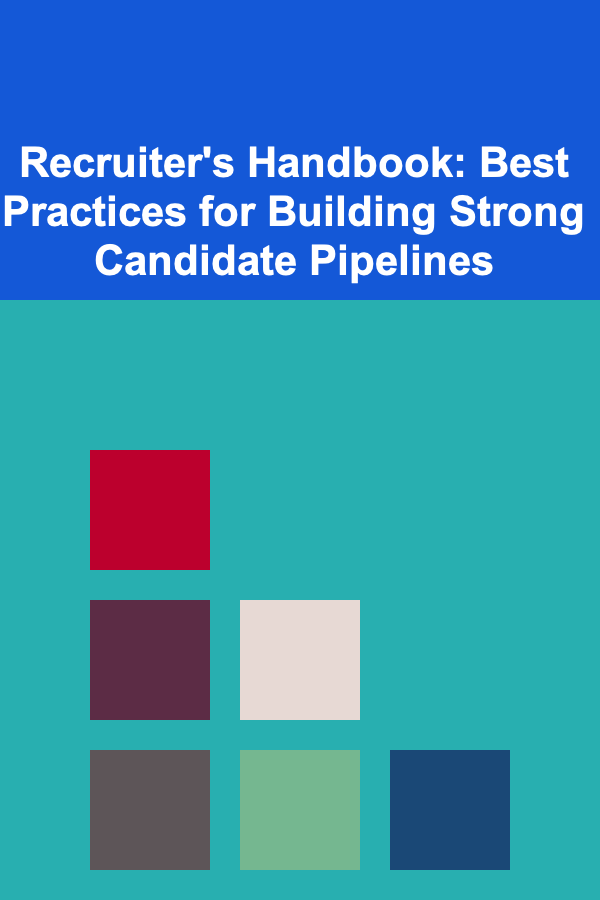
Recruiter's Handbook: Best Practices for Building Strong Candidate Pipelines
ebook include PDF & Audio bundle (Micro Guide)
$12.99$11.99
Limited Time Offer! Order within the next:

Building a strong candidate pipeline is crucial for any recruitment process. It ensures that organizations are always ready to hire top talent when needed, making recruitment more efficient, effective, and agile. A solid pipeline isn't something that happens overnight; it requires careful planning, strategic efforts, and ongoing maintenance. Whether you are a seasoned recruiter or just starting in the field, this guide will provide actionable strategies for building and maintaining a robust candidate pipeline.
Understanding the Importance of a Strong Candidate Pipeline
A candidate pipeline is essentially a pool of pre-screened and pre-qualified candidates who are ready for future job openings. Having a well-organized and robust pipeline allows recruiters to fill roles quickly without starting from scratch each time a new position opens up. This proactive approach significantly reduces time-to-hire, ensures you don't lose out on top candidates, and helps to cultivate long-term relationships with potential hires.
Why is it Important?
- Time Efficiency: With an established pipeline, recruiters don't need to go through the same lengthy search process for every vacancy. This means faster placements and fewer disruptions for the company.
- Access to Top Talent: A pipeline allows you to build relationships with high-quality candidates in advance, ensuring that when a job opens, you're able to quickly reach out to the most qualified individuals.
- Reduced Costs: Recruitment is expensive. A strong candidate pipeline can reduce reliance on paid job boards and recruiting agencies, which in turn reduces the overall cost per hire.
- Market Reputation: Companies that are known for maintaining strong relationships with candidates often have a good reputation in the talent market. This can help attract better talent, even in competitive industries.
Building a Strong Candidate Pipeline: Best Practices
1. Develop a Clear Recruiting Strategy
The first step to building a successful candidate pipeline is having a clear, well-defined recruiting strategy. This means setting goals for what you want to achieve and ensuring that your approach aligns with the company's overall business objectives. Without this clarity, you may end up attracting the wrong candidates or spending resources inefficiently.
Key Elements of a Recruiting Strategy:
- Define Target Candidates: Determine the types of candidates you need, including their skills, qualifications, and experience.
- Forecast Hiring Needs: Predict future hiring needs based on company growth, turnover, and industry trends.
- Build Relationships with Hiring Managers: Work closely with hiring managers to understand their needs and the specific qualities they are looking for in candidates.
2. Leverage Technology to Streamline the Process
Recruiting technology can be a game-changer when building and maintaining your candidate pipeline. Applicant Tracking Systems (ATS), CRM tools, and other recruitment technologies help manage candidates, track communication, and automate various aspects of the hiring process.
Tools to Consider:
- Applicant Tracking System (ATS): A good ATS can help you organize your candidate database, track where candidates are in the hiring process, and keep detailed notes on every interaction.
- Recruitment CRM: A Candidate Relationship Management (CRM) system allows you to nurture relationships with potential candidates, even when no positions are available. These systems allow you to segment and communicate with candidates efficiently.
- Job Boards & Social Media: Make use of both paid and free platforms like LinkedIn, Indeed, Glassdoor, and others to build your candidate pool. Social media can be a powerful tool to engage with passive candidates who may not actively be job hunting but are open to opportunities.
3. Engage in Active Sourcing
Building a pipeline requires more than just posting job ads and waiting for resumes to roll in. Active sourcing---going out and finding candidates before you have a specific job for them---is key to creating a strong pool of talent. Passive candidates, those not actively seeking a job but open to opportunities, are often the most highly sought-after.
Strategies for Active Sourcing:
- Social Media Engagement: Actively engage with talent on social media platforms like LinkedIn, Twitter, and industry-specific forums. Share content, comment on posts, and reach out to interesting candidates.
- Talent Pools: Regularly update and engage with a group of potential candidates, even if they are not a fit for an immediate opening. This keeps them engaged for future opportunities.
- Networking: Attend industry conferences, webinars, and networking events. Building personal relationships with candidates allows you to build a stronger pipeline that goes beyond traditional job boards.
4. Create Compelling Job Descriptions
Your job descriptions are often the first point of contact with potential candidates, so it's essential to make them clear, compelling, and inclusive. A well-written job description can help you attract the right candidates and also screen out those who aren't a fit, saving time for everyone involved.
Key Tips for Writing Effective Job Descriptions:
- Focus on Skills and Responsibilities: Be clear about what the candidate will be expected to do and what qualifications are necessary.
- Be Inclusive: Avoid language that could deter certain groups of candidates from applying. Using inclusive language increases diversity and creates a broader talent pool.
- Showcase Your Culture: Highlight your company's values, mission, and work environment. Candidates are often more interested in the culture of a company than just the role itself.
5. Create and Nurture Relationships with Passive Candidates
Not every candidate will be ready to apply for a job immediately, but that doesn't mean they're not valuable. Passive candidates may not be actively looking, but they are open to hearing about opportunities. Nurturing relationships with these individuals can pay off in the long run when a suitable position opens up.
Ways to Nurture Passive Candidates:
- Regular Check-ins: Touch base with potential candidates periodically. Even if there's no role to offer, simply maintaining a relationship can lead to future opportunities.
- Engage Through Content: Send candidates relevant industry content, such as blog posts, newsletters, or invites to webinars, that will keep them engaged and interested in your company.
- Personalized Outreach: Instead of generic messages, try to personalize your communication. Show genuine interest in their career and why you think they would be a good fit for your organization.
6. Create a Positive Candidate Experience
The candidate experience is crucial for ensuring that top talent stays engaged in your pipeline. Every interaction a candidate has with your company---whether it's an email, a phone interview, or an in-person meeting---should reflect well on your organization.
Tips for Improving Candidate Experience:
- Clear Communication: Keep candidates informed about where they are in the process. If they're not selected for a particular role, let them know respectfully and offer feedback if appropriate.
- Respect Time: Be mindful of candidates' time. Avoid unnecessary delays, and be prompt with interviews and follow-ups.
- Personalized Feedback: If a candidate isn't selected for a role, offering personalized feedback can help them improve and leave a positive impression of your company.
7. Track and Analyze Your Recruitment Data
Building a pipeline doesn't end once candidates are added to your system. To optimize your pipeline and make informed decisions, you must continually track and analyze your recruitment data.
Key Metrics to Track:
- Source of Hire: Understand where your candidates are coming from (e.g., LinkedIn, job boards, referrals) to focus on the most effective channels.
- Time-to-Hire: Measure how long it takes to move candidates from initial contact to hire. This can help identify inefficiencies in your recruitment process.
- Candidate Drop-off Rates: Track where candidates drop off during the recruitment process and identify ways to improve the candidate journey.
8. Maintain Continuous Engagement with Your Pipeline
Once your pipeline is established, it's crucial to keep candidates engaged, even if no immediate positions are available. Regular engagement can ensure that when a role does open, the candidates are still interested and available.
Ways to Maintain Engagement:
- Email Campaigns: Keep candidates informed about company news, job openings, and industry trends via email newsletters.
- Host Webinars or Virtual Meetups: Create opportunities for potential candidates to engage with your company in an informal setting, learning about your culture and what you do.
- Celebrate Successes: Share success stories of current employees or highlight major company achievements. This fosters a sense of connection and interest in your organization.
Conclusion
Building and maintaining a strong candidate pipeline is not just about filling vacancies; it's about creating a strategic, ongoing process that ensures your organization always has access to top talent. By following best practices such as using technology, engaging in active sourcing, nurturing relationships with passive candidates, and optimizing the candidate experience, you can create a dynamic and responsive recruitment pipeline. This proactive approach not only reduces the time to hire but also builds long-term relationships with candidates, improving your hiring outcomes and ensuring your company's continued success.

How to Build a Checklist for Estimated Tax Payments
Read More
How to Build a Functional Storage Closet in an Unused Corner
Read More
How to Create a Family Emergency Plan for Home Security
Read More
How to Plan a Family DIY Building Project
Read More
How To Practice Intentional Living
Read More
How to Save Money on Home Maintenance
Read MoreOther Products

How to Build a Checklist for Estimated Tax Payments
Read More
How to Build a Functional Storage Closet in an Unused Corner
Read More
How to Create a Family Emergency Plan for Home Security
Read More
How to Plan a Family DIY Building Project
Read More
How To Practice Intentional Living
Read More